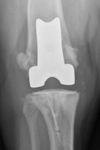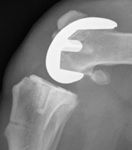Surgery STAT: An inside look at total knee replacement
Total knee replacement is a treatment option for nonseptic advanced osteoarthritis and irreparable traumatic injuries when medical management is no longer adequate, reconstructive surgery does not have a good prognosis and arthrodesis and amputation are the other options.
EDITOR'S NOTE:
SurgerySTAT is a collaborative column between the American College of Veterinary Surgeons (ACVS) and DVM Newsmagazine.

Photo 1
Total knee replacement (TKR) is a treatment option for nonseptic advanced osteoarthritis and irreparable traumatic injuries when medical management is no longer adequate, reconstructive surgery does not have a good prognosis and arthrodesis and amputation are the other options. Veterinarians should be aware of the TKR benefits for dogs because the public is well-informed about this procedure in people, with more than 400,000 knee replacement surgeries performed in people annually in the United States.

Photo 2
The TKR prosthesis consists of two implants designed to mimic the anatomy and function of a normal joint: a cobalt chromium alloy femoral component and a monobloc ultra-high molecular weight polyethylene (UHMWPE) tibial component (Photo 1). The fixation surface of the femoral component is covered with cobalt-chromium beads intended for cementless (biological) fixation, although cement fixation can be used if needed. The UHMWPE tibial component is designed for bone cement fixation. Cementless tibial components will be available in the near future. Currently, the patella is not resurfaced. Multiple sizes are available, with total interchangeability of the femoral and tibial components for optimal fit in dogs weighing more than 15 kg.

Photo 3
The prosthesis and instrumentation are designed specifically for dogs. Details of the surgical technique and outcomes have been reported. Guide systems reference anatomical landmarks to ensure correct implant positioning to allow normal range of motion. Trial components confirm accurate bed preparation, proper implant sizing, desired collateral ligament tensioning and adequate joint stability before the prosthesis is implanted.
Rehabilitation should begin immediately after surgery with supported gait, passive range of motion exercises to maintain extension and flexion and modalities (cold packs and therapeutic LASER) to minimize inflammation. Systemic and local pain management is recommended to allow early return to function. Progressive, more active exercise begins two to four weeks after surgery, preferably in an underwater treadmill prior to land-based exercises to slowly introduce forces through the prosthesis and periarticular soft tissues.
Objective measures of joint extension, range of motion, maximum weight-bearing force during stride (peak vertical force) and total load bearing during stride (impulse) provide evidence of statistically significant improvements. Thigh muscle girth returns to normal with increased limb usage. Joint flexion returns to, or remains, normal. All measured values of TKR limb function are expected to exceed the contralateral side if contralateral osteoarthritis is present. The severity of the preoperative periarticular soft tissue and bone changes may negatively affect rehabilitation and, ultimately, the degree of recovery. When these changes are extremely severe, some limitation in function may be present in dogs, as in people, following knee replacement surgery. Because of the variable severity of preoperative osteoarthritis, it is not yet completely clear how quickly and to what extent each individual dog can resume vigorous or strenuous activity after TKR. Radiographic evidence indicates that the bone-cement-implant interfaces are acceptable for active dogs after > 1 year of follow-up (Photos 2 and 3).
Risks and complications of TKR are minimal and are similar to those for any joint replacement surgery. Expectations following TKR should be discussed because some owners expect high levels of activity (see the "Surgical Success" link below to view related videos) that may be even greater than activity levels before the onset of osteoarthritis and higher than those that are expected after TKR in people.
Based on this early experience, TKR is a viable option to treat dogs with severe osteoarthritis. Objective clinical data show significant functional improvement consistent with a less painful joint. The surgical technique, instrumentation and variety of prosthesis sizes facilitate TKR in dogs of various sizes and breeds. The methods used to secure the prosthesis, at least for the intermediate term of more than four years, are adequate. Owners should be prepared to commit to a realistic postoperative rehabilitation program that will result in improved function compared with function before surgery but not necessarily equivalent to a completely normal contralateral joint. Perhaps after additional experience and results are gained, earlier TKR intervention will be considered for dogs before marked limb muscle atrophy and severe dysfunction occur because of moderate to severe end-stage osteoarthritis, allowing for optimal outcomes.
Dr. Liska is a founder of Gulf Coast Veterinary Surgery and Gulf Coast Veterinary Specialists in Houston. He became board-certified by the American College of Veterinary Surgeons in 1980.
Pre-op prior to total knee replacement surgery
1 month following total knee replacement surgery
7 months after total knee replacement surgery